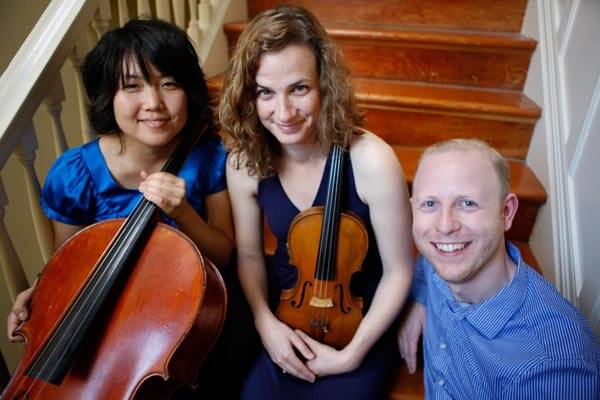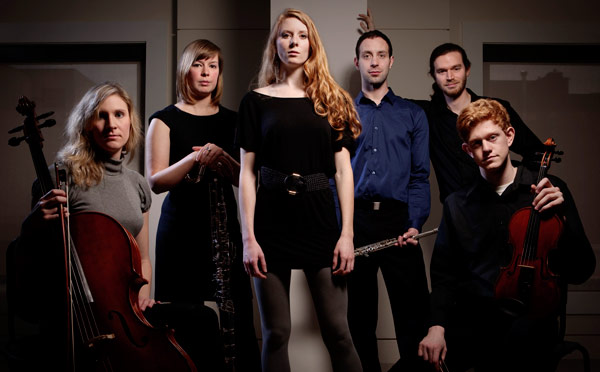 The San Francisco Conservatory of Music hosted the Inaugural Concert of the Transcendent Pathways concert series on Monday, October 7, 2013. Featuring modern staples as well as a world premiere, the concert served as a kickoff event for the eponymous organization, a donation-based effort aiming to explore the healing power of music by bringing it to the mentally ill and suffering in a variety of settings.
The San Francisco Conservatory of Music hosted the Inaugural Concert of the Transcendent Pathways concert series on Monday, October 7, 2013. Featuring modern staples as well as a world premiere, the concert served as a kickoff event for the eponymous organization, a donation-based effort aiming to explore the healing power of music by bringing it to the mentally ill and suffering in a variety of settings.

Delphi Trio: Michelle Kwon, Liana Bérubé, and Jeffrey LaDeur (photo credit: thedelphitrio.com)
The first half of the program consisted of two works of dramatically different affects: Arvo Pärt’s Spiegel im Spiegel, performed by Jeffrey LaDeur and Liana Bérubé of the Delphi Trio, and Arnold Schoenberg’s Pierrot Lunaire, performed by Nonsemble 6. These works are opposites in nearly every way. Spiegel is a concise, hypnotically repetitive eight minutes of consonance, while Pierrot is a dizzying and dissonant monstrosity that clocks in at around a half-hour, with few measures looking anything like the measure preceding it. The sole unifying element of these pieces – hence the reason for their inclusion on this series – is their inward-looking nature.
Pärt’s sound-world is abstract in such a way that makes it feel simultaneously universal and personal. But it is the latter that becomes particularly apparent in works like Spiegel im Spiegel, a work for single-line instrument (in this case, violin) and piano. Consisting of a lulling arpeggio figure in triple time on the piano that is cast against a violin line that gently arcs up and down in increasingly greater cycles, Pärt directs his musical focus inward, on the development of simple material using simple means, producing a kind of reflective stasis on which the listeners can turn their own thoughts. Pianist LaDeur and violinist Bérubé did a wonderful job of conveying the elegant fragility of Pärt’s world, playing with an expressiveness that began frail and blossomed into a fuller sound as the music developed.

Nosemble 6 (photo credit: Matthew Washburn)
Schoenberg’s work, in its grotesquely surreal imagery, paints the haunting portrait of a tormented soul (or, rather, several souls). Much of the text material creates a feeling that is almost hallucinatory (“giant black moths blot out the sun”), which in the context of this particular concert could allow the listener to make an empathetic connection to mental illness. Other lines (“how shall [Pierrot] paint himself today?”) spoke more broadly to issues that all of us face, whether we deal with giant black moths or not. Nonsemble 6, who has championed the work for the past four years or so, created a sensual experience that was utterly saturated with artistic pairings (quadruplings? quintuplings?), from theatrical stage movement (they play from memory), pantomime, projected artwork and supertitles, and mod-inspired costumes. Despite the immense amount of musical, visual and theatrical information on-stage, the intensely personal and internal nature of Pierrot undoubtedly shone through.
The ideas of empathy and human affliction were important themes throughout the evening. As founder and host Mark Ackerley and guest speaker, cognitive neuroscientist Indre Viskontes, noted, these are crucial to the mission of Transendent Pathways as an organization. Ackerley surmised in his thoughtful and thought-provoking speech at intermission that human affliction, that feeling we all get that makes us feel profoundly alone, and the universal healing and uniting nature of music are opposing forces. We can, he said, directly counteract the agony of loneliness with the ecstasy of music. Viskontes elaborated on Ackerley’s ideas, claiming “there’s plenty of science to back him up.”

Composer Mark Ackerley (photo credit: markackerley.com)
It was the concept of opposing duality of human affliction and music that was explored directly in Ackerley’s own composition, Agony/Ecstasy. After his grandmother, who suffered from bipolar disorder, took her own life, Ackerley sought to create a sort of musical reprieve for her and her next of kin, citing the statistic that relatives of those who commit suicide are three times as likely to do it themselves. As a result, the composer’s effort acted as a sort of musical credo for his organization’s mission – to literally cancel out the negativity of human affliction through the act of music.
The impetus for Ackerley’s piece was a loaded one, setting lofty expectations for the sounds that were about to emanate from the 80-some piece Magik*Magik Orchestra. Fortunately, the experience that followed was a moving one, as Ackerley’s work pulsed and shimmered with beauty. Despite moments of dramatic intensity, there was ample room for introspection and intimacy – a gently pulsing musical life-line was threaded through the ebb and flow of the score, and a solo violin part cast against the large forces of the orchestra effectively painted a portrait of a lone soul against the unknown. I hesitate to say much more about a piece so personal and profound in its disposition. Fortunately, Ackerley has made the recording of the premiere available on SoundCloud.
The SF Conservatory was a fitting location for this event, which featured exclusively groups that were founded by alumni of the school. It also highlighted the sense of cross-pollination that is so characteristic of the San Francisco new music scene. Nearly all of the performers play in multiple groups, and most of them played twice on the program – violinist Bérubé, for example, returned in the second half to perform the virtuosic solo part in Ackerley’s premiere. The latter piece in particular, with Magik*Magik Orchestra drawing heavily from the pool of SFCM alumni, also served as a veritable who’s who of the new music community’s up-and-coming chamber musicians. The buzz of the concert space was energized and packed with model examples of the SF new music scene: young (or young at heart, anyway), entrepreneurial, and determined to make a positive change through music. Any concert that can create more of that, in my opinion, deserves a good review.






















